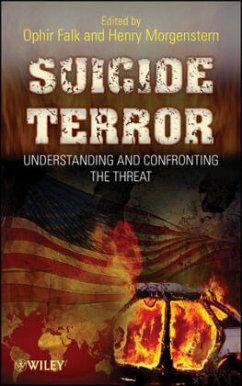Suicide Terror
Herausgegeben von Falk, Ophir; Morgenstern, Henry
Suicide Terror
Herausgegeben von Falk, Ophir; Morgenstern, Henry
- Gebundenes Buch
- Merkliste
- Auf die Merkliste
- Bewerten Bewerten
- Teilen
- Produkt teilen
- Produkterinnerung
- Produkterinnerung
Based on original material, this book looks at the US and Israeli experiences dealing with the weapon of suicide terror. The authors draw conclusions about the future use of the weapon in the US and provide the policy maker, first responder, and student of homeland security with a thorough understanding of this weapon. The text creates, through re-enactments based on eyewitness testimony, the look and feel of actual incidents. Utilizing extensive case studies, this definitive study of suicide terror points out how best to prevent and confront this very dangerous threat.
Andere Kunden interessierten sich auch für
![Personal Protective Equipment for Chemical, Biological, and Radiological Hazards Personal Protective Equipment for Chemical, Biological, and Radiological Hazards]() Eva F. Gudgin DicksonPersonal Protective Equipment for Chemical, Biological, and Radiological Hazards177,99 €
Eva F. Gudgin DicksonPersonal Protective Equipment for Chemical, Biological, and Radiological Hazards177,99 €![Falls from Height Falls from Height]() Loui McCurleyFalls from Height96,99 €
Loui McCurleyFalls from Height96,99 €![A Guide to Virology for Engineers and Applied Scientists A Guide to Virology for Engineers and Applied Scientists]() Megan M. ReynoldsA Guide to Virology for Engineers and Applied Scientists139,99 €
Megan M. ReynoldsA Guide to Virology for Engineers and Applied Scientists139,99 €![Managing Cybersecurity in the Process Industries Managing Cybersecurity in the Process Industries]() Center for Chemical Process Safety (CCPS)Managing Cybersecurity in the Process Industries163,99 €
Center for Chemical Process Safety (CCPS)Managing Cybersecurity in the Process Industries163,99 €![Physical and Biological Hazards of the Workplace Physical and Biological Hazards of the Workplace]() Physical and Biological Hazards of the Workplace154,99 €
Physical and Biological Hazards of the Workplace154,99 €![Fuel and Combustion Systems Safety Fuel and Combustion Systems Safety]() John R. PuskarFuel and Combustion Systems Safety99,99 €
John R. PuskarFuel and Combustion Systems Safety99,99 €![Life Cycle Assessment Handbook Life Cycle Assessment Handbook]() Mary Ann CurranLife Cycle Assessment Handbook222,99 €
Mary Ann CurranLife Cycle Assessment Handbook222,99 €-
-
-
Based on original material, this book looks at the US and Israeli experiences dealing with the weapon of suicide terror. The authors draw conclusions about the future use of the weapon in the US and provide the policy maker, first responder, and student of homeland security with a thorough understanding of this weapon. The text creates, through re-enactments based on eyewitness testimony, the look and feel of actual incidents. Utilizing extensive case studies, this definitive study of suicide terror points out how best to prevent and confront this very dangerous threat.
Produktdetails
- Produktdetails
- Verlag: Wiley & Sons
- 1. Auflage
- Seitenzahl: 432
- Erscheinungstermin: 1. Juli 2009
- Englisch
- Abmessung: 236mm x 160mm x 25mm
- Gewicht: 778g
- ISBN-13: 9780470087299
- ISBN-10: 0470087293
- Artikelnr.: 25932667
- Herstellerkennzeichnung
- Libri GmbH
- Europaallee 1
- 36244 Bad Hersfeld
- gpsr@libri.de
- Verlag: Wiley & Sons
- 1. Auflage
- Seitenzahl: 432
- Erscheinungstermin: 1. Juli 2009
- Englisch
- Abmessung: 236mm x 160mm x 25mm
- Gewicht: 778g
- ISBN-13: 9780470087299
- ISBN-10: 0470087293
- Artikelnr.: 25932667
- Herstellerkennzeichnung
- Libri GmbH
- Europaallee 1
- 36244 Bad Hersfeld
- gpsr@libri.de
Ophir Falk is a Partner at the Naveh, Kantor, Even-Har law firm and a Research Fellow at the International Institute for Counter-Terrorism, where he has published numerous articles in the field. Mr. Falk has over a decade of experience in various security capacities and served as a risk consultant for the 2004 Olympic Games, where he took part in risk assessments for Olympic venues and critical national infrastructure. Henry Morgenstern is the President of Security Solutions International, a company that has trained more than 700 federal, state, and local agencies to effectively confront the threat of terror and regularly takes groups of first responders to Israel to study homeland security. Mr. Morgenstern is a widely published author on the subject of suicide terror. He has offered expert commentary on terror-related issues for NBC, ABC, CBS, Fox, numerous radio stations, and Web broadcasts.
Preface.
Acknowledgments.
Contributors.
INTRODUCTION: OVERVIEW AND HISTORICAL ACCOUNT OF THE WEAPON (Ophir Falk).
Background.
Defining the Threat.
Definition Criteria.
Proposed Definitions.
Analyses of Data.
Overview.
Endnotes.
1 THE GLOBAL JIHAD (Henry Morgenstern).
Introduction: Where Is the Jihad Today?
Do We Need to Know Why?
The Meaning of Jihad for the Jihadists (Mujahedeen).
The Origins and Evolution of the Global Jihad.
Osama bin Laden and Dr. Ayman al-Zawahiri-The Al-Qaeda View of the Jihad.
Support for the Global Jihad.
Seminal Ideas and Movements that Have Led to the Global Jihad.
Tauhid-The Oneness of God.
Takfir.
Jihad.
Jahaliyyah.
The Spread of the Jihad Across the World.
Case Study of Jihad Development: Egypt.
The Jihad in the United States.
Toward a Legal Definition of Terrorism in the United States.
Financing and Organization.
The Jihad: Version 2.0.
The Jihad's Virtual 007.
Real-Time Threat Example.
Understanding Techno-Intelligence Signatures.
Internet Activity and Terrorist Finance-Synergy in Cyberspace.
The Global Jihad Has a New Home Base-The Internet.
Conclusions.
Appendix 1: Internet Sites and the Global Jihad.
Appendix 2: Incidents in the United States since 9/11.
Endnotes.
2 ISRAEL'S CONFRONTATION WITH SUICIDE TERRORISM (Amir Kulick).
Background.
Arab-Israeli Conflict.
The First Circle: The Palestinian Suicide Bomber and His Motives.
The Second Circle: The Organizational Wrapping.
The Third Circle: The Social Wrapping.
How Has Israel Confronted Suicide Terrorism?
The Prevention Circle.
The Delay Circle.
The Consequence Mitigation Circle.
The Intelligence Level.
The Intelligence Challenge in the War on Suicide Terrorism.
Israeli Intelligence.
The Operational Level.
The Evolution of Israel's Responses to Suicide Terrorism-A Brief Historic
Review.
The Israeli Methods of Action.
Targeted Killing.
Passive Measures.
Public Resilience.
Deterring Suicide Bombers.
Relevant Lessons for American Law Enforcement.
Key Lessons Learned-Operative Level.
Specific Lessons-Operational-Tactical Level.
Summary and Conclusions.
Endnotes.
3 THE EAGLE AND THE SNAKE: AMERICA'S EXPERIENCE WITH SUICIDE BOMBINGS (
Yaron Schwartz).
The Origins of Suicide Attacks Against the United States.
Suicide Bombings in Iraq.
The Insurgency: Who, Why, When, and How.
The Role of Suicide Bombings.
Assessing the Surge.
The Impact of Iraq and Its Lessons.
Future Threats and Suicide Terrorism.
Endnotes.
Bibliograhy.
4 THE INTERNATIONALIZATION OF SUICIDE TERRORISM (Ophir Falk and Hadas
Kroitoru).
Lebanon.
Hezbollah.
Hezbollah's International Reach.
The Iran-Hezbollah-al-Qaeda Connection.
Hezbollah's Direct Threat to U.S. Homeland.
Sri Lanka.
A History of Conflict.
The Tamil Tigers and Suicide Terrorism.
Consequences and Counterterrorism Efforts.
Israel.
Historical Background.
A Decade and a Half of Suicide Terrorism.
Misconceptions.
From Deterrence to Prevention and Preemption.
Relevance to U.S. Homeland Security.
Operational Lessons.
India.
History of Conflict.
India's Experience with Suicide Terrorism.
Turkey.
Civil War and Civil Strife: The PKK's Answer to the "Kurdish Question".
Turkey's Experience with Suicide Terror.
Islamic Groups Step Up to the Plate.
Turkish Counterterrorism Tactics.
Lessons from Turkey's Experience with Suicide Terrorism.
Al-Qaeda.
Establishing the "Base".
Al-Qaeda Organization: Affiliates and Networks.
Al-Qaeda Attacks.
Al-Qaeda in Europe.
Al-Qaeda in Southeast Asia.
Consequences and Counterterrorism.
The Future of al-Qaeda.
Chechnya.
History of Conflict.
Chechen Separatists and Suicide Terrorism.
Consequences and Counterterrorism.
Summary and Conclusions-The Internationalization of Suicide Terrorism.
Endnotes.
5 HIGH-RISK SCENARIOS AND FUTURE TRENDS (Ophir Falk).
Scenario No. 1: Cyber and Physical Attack on Energy Distribution Systems.
Description of Scenario.
Vulnerability.
Consequence.
Means of Mitigation.
Scenario No. 2: Attacks on and by Civilian Aircraft-Back to the Future.
Description of Scenario.
Vulnerability.
Consequence.
Means of Mitigation.
Prosperity or Security in the Maritime Trade.
Scenario No. 3: Dirty Bomb in Maritime Container.
Description of Scenario.
Vulnerability.
Consequence.
Means of Mitigation.
Scenario No. 4: Blocking World Oil Transit by Sea (Ofer Israeli).
Description of Scenario.
Vulnerability.
Consequence.
Means of Mitigation.
Scenario No. 5: PC Doomsday.
Description of Scenario.
Vulnerability.
Consequence.
Means of Mitigation.
Scenario No. 6: Suicide Terrorist Attack on Subway Followed by a Suicide
Terrorist Attack on Premises of a Level I Trauma Center (Shmuel C.
Shapira).
Description of Scenario.
Vulnerability.
Consequence.
Means of Mitigation.
Future Trends.
Endnotes.
6 METHODS FOR CONFRONTING SUICIDE TERROR (William Cooper).
Detection of Key Terrorist Activities.
The Suicide Bomber.
Detection of Terrorist Recruitment in the Community.
Identifying Safe Houses and Planning Centers.
Terrorist Means of Communication.
Identifying Terrorist Transportation.
Identifying Terrorist Financing.
Identifying Paper Falsification.
Land Attack Characteristics.
Sea Attack Characteristics.
Air Attack Characteristics.
The Public and the Battle Against Terrorism.
Legislation in the Battle Against Terrorism.
Negotiation Tactics to Use in Incidents of Terror.
Rules of Engagement.
Response to Suicide/Homicide Bombers.
Patrol Level Response.
Operational Philosophy.
Endnotes.
7 MEDICAL MANAGEMENT OF SUICIDE TERRORISM (Shmuel C. Shapira and Leonard A.
Cole).
Explosives.
Effects and Management of Suicide Terrorism.
Preparing for Suicide Terror Mass Casualty Incidents.
Mass Casualty Incident Management.
Pre-Hospital Management, Short Term.
Pre-Hospital Management, Prolonged Term.
Hospital Management of Suicide Terrorism.
Conclusion.
Endnotes.
Index.
Acknowledgments.
Contributors.
INTRODUCTION: OVERVIEW AND HISTORICAL ACCOUNT OF THE WEAPON (Ophir Falk).
Background.
Defining the Threat.
Definition Criteria.
Proposed Definitions.
Analyses of Data.
Overview.
Endnotes.
1 THE GLOBAL JIHAD (Henry Morgenstern).
Introduction: Where Is the Jihad Today?
Do We Need to Know Why?
The Meaning of Jihad for the Jihadists (Mujahedeen).
The Origins and Evolution of the Global Jihad.
Osama bin Laden and Dr. Ayman al-Zawahiri-The Al-Qaeda View of the Jihad.
Support for the Global Jihad.
Seminal Ideas and Movements that Have Led to the Global Jihad.
Tauhid-The Oneness of God.
Takfir.
Jihad.
Jahaliyyah.
The Spread of the Jihad Across the World.
Case Study of Jihad Development: Egypt.
The Jihad in the United States.
Toward a Legal Definition of Terrorism in the United States.
Financing and Organization.
The Jihad: Version 2.0.
The Jihad's Virtual 007.
Real-Time Threat Example.
Understanding Techno-Intelligence Signatures.
Internet Activity and Terrorist Finance-Synergy in Cyberspace.
The Global Jihad Has a New Home Base-The Internet.
Conclusions.
Appendix 1: Internet Sites and the Global Jihad.
Appendix 2: Incidents in the United States since 9/11.
Endnotes.
2 ISRAEL'S CONFRONTATION WITH SUICIDE TERRORISM (Amir Kulick).
Background.
Arab-Israeli Conflict.
The First Circle: The Palestinian Suicide Bomber and His Motives.
The Second Circle: The Organizational Wrapping.
The Third Circle: The Social Wrapping.
How Has Israel Confronted Suicide Terrorism?
The Prevention Circle.
The Delay Circle.
The Consequence Mitigation Circle.
The Intelligence Level.
The Intelligence Challenge in the War on Suicide Terrorism.
Israeli Intelligence.
The Operational Level.
The Evolution of Israel's Responses to Suicide Terrorism-A Brief Historic
Review.
The Israeli Methods of Action.
Targeted Killing.
Passive Measures.
Public Resilience.
Deterring Suicide Bombers.
Relevant Lessons for American Law Enforcement.
Key Lessons Learned-Operative Level.
Specific Lessons-Operational-Tactical Level.
Summary and Conclusions.
Endnotes.
3 THE EAGLE AND THE SNAKE: AMERICA'S EXPERIENCE WITH SUICIDE BOMBINGS (
Yaron Schwartz).
The Origins of Suicide Attacks Against the United States.
Suicide Bombings in Iraq.
The Insurgency: Who, Why, When, and How.
The Role of Suicide Bombings.
Assessing the Surge.
The Impact of Iraq and Its Lessons.
Future Threats and Suicide Terrorism.
Endnotes.
Bibliograhy.
4 THE INTERNATIONALIZATION OF SUICIDE TERRORISM (Ophir Falk and Hadas
Kroitoru).
Lebanon.
Hezbollah.
Hezbollah's International Reach.
The Iran-Hezbollah-al-Qaeda Connection.
Hezbollah's Direct Threat to U.S. Homeland.
Sri Lanka.
A History of Conflict.
The Tamil Tigers and Suicide Terrorism.
Consequences and Counterterrorism Efforts.
Israel.
Historical Background.
A Decade and a Half of Suicide Terrorism.
Misconceptions.
From Deterrence to Prevention and Preemption.
Relevance to U.S. Homeland Security.
Operational Lessons.
India.
History of Conflict.
India's Experience with Suicide Terrorism.
Turkey.
Civil War and Civil Strife: The PKK's Answer to the "Kurdish Question".
Turkey's Experience with Suicide Terror.
Islamic Groups Step Up to the Plate.
Turkish Counterterrorism Tactics.
Lessons from Turkey's Experience with Suicide Terrorism.
Al-Qaeda.
Establishing the "Base".
Al-Qaeda Organization: Affiliates and Networks.
Al-Qaeda Attacks.
Al-Qaeda in Europe.
Al-Qaeda in Southeast Asia.
Consequences and Counterterrorism.
The Future of al-Qaeda.
Chechnya.
History of Conflict.
Chechen Separatists and Suicide Terrorism.
Consequences and Counterterrorism.
Summary and Conclusions-The Internationalization of Suicide Terrorism.
Endnotes.
5 HIGH-RISK SCENARIOS AND FUTURE TRENDS (Ophir Falk).
Scenario No. 1: Cyber and Physical Attack on Energy Distribution Systems.
Description of Scenario.
Vulnerability.
Consequence.
Means of Mitigation.
Scenario No. 2: Attacks on and by Civilian Aircraft-Back to the Future.
Description of Scenario.
Vulnerability.
Consequence.
Means of Mitigation.
Prosperity or Security in the Maritime Trade.
Scenario No. 3: Dirty Bomb in Maritime Container.
Description of Scenario.
Vulnerability.
Consequence.
Means of Mitigation.
Scenario No. 4: Blocking World Oil Transit by Sea (Ofer Israeli).
Description of Scenario.
Vulnerability.
Consequence.
Means of Mitigation.
Scenario No. 5: PC Doomsday.
Description of Scenario.
Vulnerability.
Consequence.
Means of Mitigation.
Scenario No. 6: Suicide Terrorist Attack on Subway Followed by a Suicide
Terrorist Attack on Premises of a Level I Trauma Center (Shmuel C.
Shapira).
Description of Scenario.
Vulnerability.
Consequence.
Means of Mitigation.
Future Trends.
Endnotes.
6 METHODS FOR CONFRONTING SUICIDE TERROR (William Cooper).
Detection of Key Terrorist Activities.
The Suicide Bomber.
Detection of Terrorist Recruitment in the Community.
Identifying Safe Houses and Planning Centers.
Terrorist Means of Communication.
Identifying Terrorist Transportation.
Identifying Terrorist Financing.
Identifying Paper Falsification.
Land Attack Characteristics.
Sea Attack Characteristics.
Air Attack Characteristics.
The Public and the Battle Against Terrorism.
Legislation in the Battle Against Terrorism.
Negotiation Tactics to Use in Incidents of Terror.
Rules of Engagement.
Response to Suicide/Homicide Bombers.
Patrol Level Response.
Operational Philosophy.
Endnotes.
7 MEDICAL MANAGEMENT OF SUICIDE TERRORISM (Shmuel C. Shapira and Leonard A.
Cole).
Explosives.
Effects and Management of Suicide Terrorism.
Preparing for Suicide Terror Mass Casualty Incidents.
Mass Casualty Incident Management.
Pre-Hospital Management, Short Term.
Pre-Hospital Management, Prolonged Term.
Hospital Management of Suicide Terrorism.
Conclusion.
Endnotes.
Index.
Preface.
Acknowledgments.
Contributors.
INTRODUCTION: OVERVIEW AND HISTORICAL ACCOUNT OF THE WEAPON (Ophir Falk).
Background.
Defining the Threat.
Definition Criteria.
Proposed Definitions.
Analyses of Data.
Overview.
Endnotes.
1 THE GLOBAL JIHAD (Henry Morgenstern).
Introduction: Where Is the Jihad Today?
Do We Need to Know Why?
The Meaning of Jihad for the Jihadists (Mujahedeen).
The Origins and Evolution of the Global Jihad.
Osama bin Laden and Dr. Ayman al-Zawahiri-The Al-Qaeda View of the Jihad.
Support for the Global Jihad.
Seminal Ideas and Movements that Have Led to the Global Jihad.
Tauhid-The Oneness of God.
Takfir.
Jihad.
Jahaliyyah.
The Spread of the Jihad Across the World.
Case Study of Jihad Development: Egypt.
The Jihad in the United States.
Toward a Legal Definition of Terrorism in the United States.
Financing and Organization.
The Jihad: Version 2.0.
The Jihad's Virtual 007.
Real-Time Threat Example.
Understanding Techno-Intelligence Signatures.
Internet Activity and Terrorist Finance-Synergy in Cyberspace.
The Global Jihad Has a New Home Base-The Internet.
Conclusions.
Appendix 1: Internet Sites and the Global Jihad.
Appendix 2: Incidents in the United States since 9/11.
Endnotes.
2 ISRAEL'S CONFRONTATION WITH SUICIDE TERRORISM (Amir Kulick).
Background.
Arab-Israeli Conflict.
The First Circle: The Palestinian Suicide Bomber and His Motives.
The Second Circle: The Organizational Wrapping.
The Third Circle: The Social Wrapping.
How Has Israel Confronted Suicide Terrorism?
The Prevention Circle.
The Delay Circle.
The Consequence Mitigation Circle.
The Intelligence Level.
The Intelligence Challenge in the War on Suicide Terrorism.
Israeli Intelligence.
The Operational Level.
The Evolution of Israel's Responses to Suicide Terrorism-A Brief Historic
Review.
The Israeli Methods of Action.
Targeted Killing.
Passive Measures.
Public Resilience.
Deterring Suicide Bombers.
Relevant Lessons for American Law Enforcement.
Key Lessons Learned-Operative Level.
Specific Lessons-Operational-Tactical Level.
Summary and Conclusions.
Endnotes.
3 THE EAGLE AND THE SNAKE: AMERICA'S EXPERIENCE WITH SUICIDE BOMBINGS (
Yaron Schwartz).
The Origins of Suicide Attacks Against the United States.
Suicide Bombings in Iraq.
The Insurgency: Who, Why, When, and How.
The Role of Suicide Bombings.
Assessing the Surge.
The Impact of Iraq and Its Lessons.
Future Threats and Suicide Terrorism.
Endnotes.
Bibliograhy.
4 THE INTERNATIONALIZATION OF SUICIDE TERRORISM (Ophir Falk and Hadas
Kroitoru).
Lebanon.
Hezbollah.
Hezbollah's International Reach.
The Iran-Hezbollah-al-Qaeda Connection.
Hezbollah's Direct Threat to U.S. Homeland.
Sri Lanka.
A History of Conflict.
The Tamil Tigers and Suicide Terrorism.
Consequences and Counterterrorism Efforts.
Israel.
Historical Background.
A Decade and a Half of Suicide Terrorism.
Misconceptions.
From Deterrence to Prevention and Preemption.
Relevance to U.S. Homeland Security.
Operational Lessons.
India.
History of Conflict.
India's Experience with Suicide Terrorism.
Turkey.
Civil War and Civil Strife: The PKK's Answer to the "Kurdish Question".
Turkey's Experience with Suicide Terror.
Islamic Groups Step Up to the Plate.
Turkish Counterterrorism Tactics.
Lessons from Turkey's Experience with Suicide Terrorism.
Al-Qaeda.
Establishing the "Base".
Al-Qaeda Organization: Affiliates and Networks.
Al-Qaeda Attacks.
Al-Qaeda in Europe.
Al-Qaeda in Southeast Asia.
Consequences and Counterterrorism.
The Future of al-Qaeda.
Chechnya.
History of Conflict.
Chechen Separatists and Suicide Terrorism.
Consequences and Counterterrorism.
Summary and Conclusions-The Internationalization of Suicide Terrorism.
Endnotes.
5 HIGH-RISK SCENARIOS AND FUTURE TRENDS (Ophir Falk).
Scenario No. 1: Cyber and Physical Attack on Energy Distribution Systems.
Description of Scenario.
Vulnerability.
Consequence.
Means of Mitigation.
Scenario No. 2: Attacks on and by Civilian Aircraft-Back to the Future.
Description of Scenario.
Vulnerability.
Consequence.
Means of Mitigation.
Prosperity or Security in the Maritime Trade.
Scenario No. 3: Dirty Bomb in Maritime Container.
Description of Scenario.
Vulnerability.
Consequence.
Means of Mitigation.
Scenario No. 4: Blocking World Oil Transit by Sea (Ofer Israeli).
Description of Scenario.
Vulnerability.
Consequence.
Means of Mitigation.
Scenario No. 5: PC Doomsday.
Description of Scenario.
Vulnerability.
Consequence.
Means of Mitigation.
Scenario No. 6: Suicide Terrorist Attack on Subway Followed by a Suicide
Terrorist Attack on Premises of a Level I Trauma Center (Shmuel C.
Shapira).
Description of Scenario.
Vulnerability.
Consequence.
Means of Mitigation.
Future Trends.
Endnotes.
6 METHODS FOR CONFRONTING SUICIDE TERROR (William Cooper).
Detection of Key Terrorist Activities.
The Suicide Bomber.
Detection of Terrorist Recruitment in the Community.
Identifying Safe Houses and Planning Centers.
Terrorist Means of Communication.
Identifying Terrorist Transportation.
Identifying Terrorist Financing.
Identifying Paper Falsification.
Land Attack Characteristics.
Sea Attack Characteristics.
Air Attack Characteristics.
The Public and the Battle Against Terrorism.
Legislation in the Battle Against Terrorism.
Negotiation Tactics to Use in Incidents of Terror.
Rules of Engagement.
Response to Suicide/Homicide Bombers.
Patrol Level Response.
Operational Philosophy.
Endnotes.
7 MEDICAL MANAGEMENT OF SUICIDE TERRORISM (Shmuel C. Shapira and Leonard A.
Cole).
Explosives.
Effects and Management of Suicide Terrorism.
Preparing for Suicide Terror Mass Casualty Incidents.
Mass Casualty Incident Management.
Pre-Hospital Management, Short Term.
Pre-Hospital Management, Prolonged Term.
Hospital Management of Suicide Terrorism.
Conclusion.
Endnotes.
Index.
Acknowledgments.
Contributors.
INTRODUCTION: OVERVIEW AND HISTORICAL ACCOUNT OF THE WEAPON (Ophir Falk).
Background.
Defining the Threat.
Definition Criteria.
Proposed Definitions.
Analyses of Data.
Overview.
Endnotes.
1 THE GLOBAL JIHAD (Henry Morgenstern).
Introduction: Where Is the Jihad Today?
Do We Need to Know Why?
The Meaning of Jihad for the Jihadists (Mujahedeen).
The Origins and Evolution of the Global Jihad.
Osama bin Laden and Dr. Ayman al-Zawahiri-The Al-Qaeda View of the Jihad.
Support for the Global Jihad.
Seminal Ideas and Movements that Have Led to the Global Jihad.
Tauhid-The Oneness of God.
Takfir.
Jihad.
Jahaliyyah.
The Spread of the Jihad Across the World.
Case Study of Jihad Development: Egypt.
The Jihad in the United States.
Toward a Legal Definition of Terrorism in the United States.
Financing and Organization.
The Jihad: Version 2.0.
The Jihad's Virtual 007.
Real-Time Threat Example.
Understanding Techno-Intelligence Signatures.
Internet Activity and Terrorist Finance-Synergy in Cyberspace.
The Global Jihad Has a New Home Base-The Internet.
Conclusions.
Appendix 1: Internet Sites and the Global Jihad.
Appendix 2: Incidents in the United States since 9/11.
Endnotes.
2 ISRAEL'S CONFRONTATION WITH SUICIDE TERRORISM (Amir Kulick).
Background.
Arab-Israeli Conflict.
The First Circle: The Palestinian Suicide Bomber and His Motives.
The Second Circle: The Organizational Wrapping.
The Third Circle: The Social Wrapping.
How Has Israel Confronted Suicide Terrorism?
The Prevention Circle.
The Delay Circle.
The Consequence Mitigation Circle.
The Intelligence Level.
The Intelligence Challenge in the War on Suicide Terrorism.
Israeli Intelligence.
The Operational Level.
The Evolution of Israel's Responses to Suicide Terrorism-A Brief Historic
Review.
The Israeli Methods of Action.
Targeted Killing.
Passive Measures.
Public Resilience.
Deterring Suicide Bombers.
Relevant Lessons for American Law Enforcement.
Key Lessons Learned-Operative Level.
Specific Lessons-Operational-Tactical Level.
Summary and Conclusions.
Endnotes.
3 THE EAGLE AND THE SNAKE: AMERICA'S EXPERIENCE WITH SUICIDE BOMBINGS (
Yaron Schwartz).
The Origins of Suicide Attacks Against the United States.
Suicide Bombings in Iraq.
The Insurgency: Who, Why, When, and How.
The Role of Suicide Bombings.
Assessing the Surge.
The Impact of Iraq and Its Lessons.
Future Threats and Suicide Terrorism.
Endnotes.
Bibliograhy.
4 THE INTERNATIONALIZATION OF SUICIDE TERRORISM (Ophir Falk and Hadas
Kroitoru).
Lebanon.
Hezbollah.
Hezbollah's International Reach.
The Iran-Hezbollah-al-Qaeda Connection.
Hezbollah's Direct Threat to U.S. Homeland.
Sri Lanka.
A History of Conflict.
The Tamil Tigers and Suicide Terrorism.
Consequences and Counterterrorism Efforts.
Israel.
Historical Background.
A Decade and a Half of Suicide Terrorism.
Misconceptions.
From Deterrence to Prevention and Preemption.
Relevance to U.S. Homeland Security.
Operational Lessons.
India.
History of Conflict.
India's Experience with Suicide Terrorism.
Turkey.
Civil War and Civil Strife: The PKK's Answer to the "Kurdish Question".
Turkey's Experience with Suicide Terror.
Islamic Groups Step Up to the Plate.
Turkish Counterterrorism Tactics.
Lessons from Turkey's Experience with Suicide Terrorism.
Al-Qaeda.
Establishing the "Base".
Al-Qaeda Organization: Affiliates and Networks.
Al-Qaeda Attacks.
Al-Qaeda in Europe.
Al-Qaeda in Southeast Asia.
Consequences and Counterterrorism.
The Future of al-Qaeda.
Chechnya.
History of Conflict.
Chechen Separatists and Suicide Terrorism.
Consequences and Counterterrorism.
Summary and Conclusions-The Internationalization of Suicide Terrorism.
Endnotes.
5 HIGH-RISK SCENARIOS AND FUTURE TRENDS (Ophir Falk).
Scenario No. 1: Cyber and Physical Attack on Energy Distribution Systems.
Description of Scenario.
Vulnerability.
Consequence.
Means of Mitigation.
Scenario No. 2: Attacks on and by Civilian Aircraft-Back to the Future.
Description of Scenario.
Vulnerability.
Consequence.
Means of Mitigation.
Prosperity or Security in the Maritime Trade.
Scenario No. 3: Dirty Bomb in Maritime Container.
Description of Scenario.
Vulnerability.
Consequence.
Means of Mitigation.
Scenario No. 4: Blocking World Oil Transit by Sea (Ofer Israeli).
Description of Scenario.
Vulnerability.
Consequence.
Means of Mitigation.
Scenario No. 5: PC Doomsday.
Description of Scenario.
Vulnerability.
Consequence.
Means of Mitigation.
Scenario No. 6: Suicide Terrorist Attack on Subway Followed by a Suicide
Terrorist Attack on Premises of a Level I Trauma Center (Shmuel C.
Shapira).
Description of Scenario.
Vulnerability.
Consequence.
Means of Mitigation.
Future Trends.
Endnotes.
6 METHODS FOR CONFRONTING SUICIDE TERROR (William Cooper).
Detection of Key Terrorist Activities.
The Suicide Bomber.
Detection of Terrorist Recruitment in the Community.
Identifying Safe Houses and Planning Centers.
Terrorist Means of Communication.
Identifying Terrorist Transportation.
Identifying Terrorist Financing.
Identifying Paper Falsification.
Land Attack Characteristics.
Sea Attack Characteristics.
Air Attack Characteristics.
The Public and the Battle Against Terrorism.
Legislation in the Battle Against Terrorism.
Negotiation Tactics to Use in Incidents of Terror.
Rules of Engagement.
Response to Suicide/Homicide Bombers.
Patrol Level Response.
Operational Philosophy.
Endnotes.
7 MEDICAL MANAGEMENT OF SUICIDE TERRORISM (Shmuel C. Shapira and Leonard A.
Cole).
Explosives.
Effects and Management of Suicide Terrorism.
Preparing for Suicide Terror Mass Casualty Incidents.
Mass Casualty Incident Management.
Pre-Hospital Management, Short Term.
Pre-Hospital Management, Prolonged Term.
Hospital Management of Suicide Terrorism.
Conclusion.
Endnotes.
Index.








